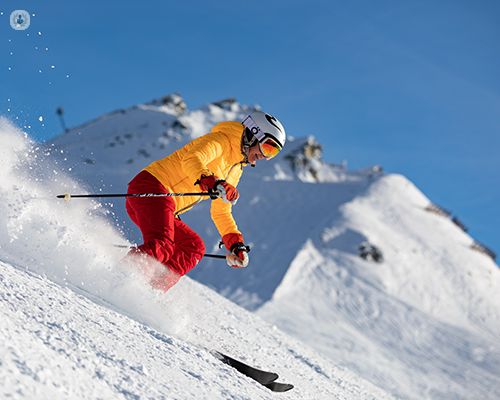A comprehensive overview of skiing injuries
Autore:Here, Professor Mohamed Imam, a highly respected consultant orthopaedic surgeon, provides us with an all-you-need-to-know guide with regards to upper limb injuries sustained whilst skiing.

Which part of the body is injured most commonly during skiing?
Skiing is a thrilling winter sport that combines speed, skill, and stunning mountain scenery. However, like any sport, it comes with the risk of injury. Among the most common injuries for skiers are those that affect the upper limbs—your arms, shoulders, wrists, and hands. Understanding these injuries, how they happen, and how to prevent and treat them can help you stay safe on the slopes.
What are the most common upper limb injuries that occur during skiing?
One frequent upper limb injury in skiing is known as skier’s thumb. This happens when the thumb is forcefully bent backward or to the side, often due to a fall where the thumb gets caught in the ski pole strap. This can stretch or tear the ligaments in the thumb, leading to pain, swelling, and difficulty gripping objects.
Wrist fractures are another common injury. Falling on an outstretched hand is a typical way to fracture your wrist while skiing. The impact can cause breaks in the bones of the wrist, resulting in pain, swelling, and bruising. Wrist fractures require medical attention and often involve immobilization with a cast or splint.
Shoulder dislocations can also occur on the slopes. A hard fall or collision can dislocate the shoulder, where the upper arm bone pops out of its socket. This injury causes severe pain, swelling, and limited movement. Immediate medical treatment is essential to properly realign the shoulder.
Rotator cuff injuries are another risk. The rotator cuff is a group of muscles and tendons that stabilise the shoulder. Skiing accidents can cause tears or strains in the rotator cuff, leading to shoulder pain, weakness, and difficulty lifting the arm.
How can upper limb injuries be prevented when skiing?
Preventing upper limb injuries involves using proper equipment, such as ensuring that your ski poles are the right size and avoiding wrist straps if possible. Properly fitted equipment reduces the risk of injuries. Warming up and stretching before hitting the slopes can prepare your muscles and joints for physical activity.
Learning and practicing proper techniques through skiing lessons can help you navigate the slopes more safely. Staying within your skill level by skiing on trails that match your abilities can also prevent accidents.
What should I do if I sustain an upper limb injury?
If you do sustain an upper limb injury, rest the affected limb and apply ice to reduce swelling and pain. Seek medical attention for severe pain, swelling, or deformity. A healthcare provider can diagnose the injury and recommend appropriate treatment, which may include immobilisation, physical therapy, or surgery.
Following medical treatment, rehabilitation exercises can help restore strength and mobility to the injured area. A physical therapist can design a specific exercise program to aid in recovery.
To book an appointment with Professor Mohamed Imam today, simply visit his Top Doctors profile.


